
September 2
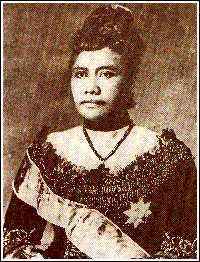
1838 Birth: Lydia Kamekeha Liliuokalani, the last monarch of Hawaii.
[See: Countdown to Infamy: Timeline to Pearl Harbor.]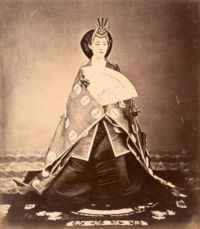
1867 Japan: Emperor Meiji weds Masako (later renamed Haruko, she will be known posthumously as Empress Shōken). She will bear no children. Her husband, however, will father fifteen children, with five official ladies-in-waiting specifically chosen for that purpose. (Satow)
1878 Birth: Werner von Blomberg: in Stargard, Germany:
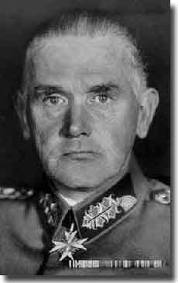
He joined the German Army and served as a second lieutenant in the 73rd Fusilier Regiment. He attended the War Academy (1904-07) before joining the General Staff in 1908. On the outbreak of the First World War, Blomberg was General Staff Officer with the 19th Reserve Division. He served on the Western Front where won the Pour le Mérite. By the end of the war he had reached the rank of major. Blomberg's two brothers were both killed in the conflict. Blomberg remained in the army and in 1920 was promoted to lieutenant colonel and was appointed Chief of Staff of the Doeberitz Brigade. Four years later General Hans von Seeckt appointed him as chief of army training . . . .
[In 1933] Adolf Hitler appointed him minister of defence and in 1935 minister of war and commander in chief of the German Army. It was Blomberg's idea to get all soldiers to pledge an oath of personal loyalty to Hitler. In April 1936 Blomberg became Hitler's first field marshal.
Blomberg believed Hitler's Night of the Long Knives massacre was justified to maintain order against Ernst Roehm's rowdy army of SA legions that threatened to eclipse the German Army itself by sheer manpower. He was outmaneuvered, however, by Hermann Goering, who was jealous of Blomberg's power and used the Gestapo to obtain embarrassing information about his pretty young second wife, who turned out to have been a prostitute with a criminal record. In January 1938, Blomberg resigned when he discovered Goering was planning make his information public. Blomberg and his wife were ordered to spend a year in exile on Capri. The scandal allowed Hitler to take direct control of the army.
After the war, Blomberg was captured by Allied troops, and gave evidence at the Nuremberg Tribunal.
1885 Whites massacre Chinese in Wyoming Territory:
On this day in 1885, 150 white miners in Rock Springs, Wyoming, brutally attack their Chinese coworkers, killing 28, wounding 15 others, and driving several hundred more out of town.[For further details, Click here]
1914 Various:

Siege of Tsingtao: Japanese forces, 23,000 soldiers with 142 artillery pieces, land on the coast of China's Shandong Province and surround the German settlement at Tsingtao (Kiautschou). The Japanese navy, independent of its own government, will soon seize several of Germany's island colonies in the Pacific (the Mariana, Caroline, and Marshall Islands) without encountering any real resistance. Note: The Japanese navy will conduct the world's first naval-launched air raids (from the Japanese seaplane carrier Wakamiya) when they attack German-held land targets in Shandong province and ships in Qiaozhou Bay during this conflict.

List Regiment (Sep 1-Oct 7): Hitler's regiment begins a short but intensive basic training program, which is held in the premises of a large public school on the Elizabeth Platz in Munich. Hitler receives the first uniform of his life; basic greenish-grey with an "RIR 16" sown in red unto the epaulettes and a red stripe down the side of the trousers. The trousers are tucked into new leather boots, topped by a thick leather belt around the waist of the uniform jacket. [For further details, Click here.]
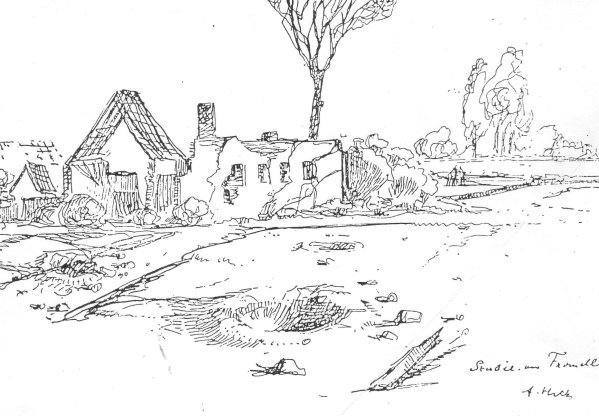
1915 World War I: Gefreiter Adolf Hitler's 16 Reserve Infantry Regiment [List Regiment] occupy a position, at Fromelles (pictured above in a drawing by Hitler), which is on a level field with water channels, willow trees and willow stalks, in the distance towards the enemy lines lie an insignificant wood with barbed wire entanglements. Under the direction of their defense-minded commander, Lieutenant General Gustav Scanzoni von Lichtenfels, the regiment works ceaselessly day and night to further fortify their position at Fromelles while fighting off repeated assaults by the enemy. [For further details, Click here.]
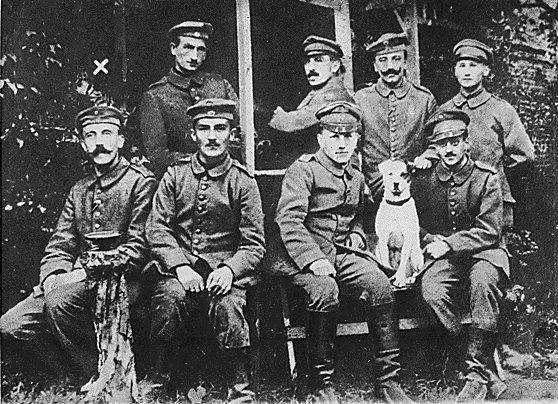
1916 World War I: Gefreiter Adolf Hitler endures trench warfare in Flanders (Artois) with 3 Company, 16 Reserve Infantry Regiment [List Regiment]. [For further details, Click here.]
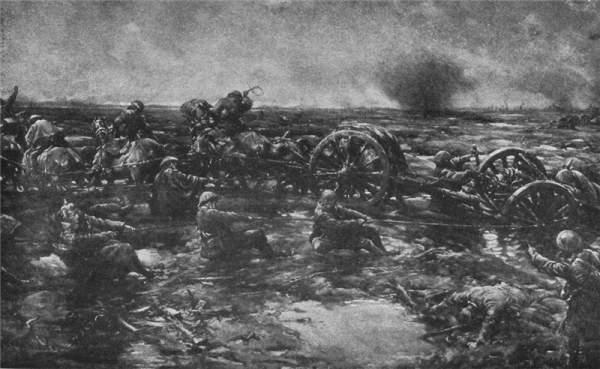
1917 Various:
World War I (July 22-September 8): Dispatch Runner Gefreiter Adolf Hitler serves at the front with 3 Company, 16 Bavarian Reserve Infantry Regiment during Phase 2 operations in Flanders. Most of their time in the trenches gas masks are worn, while English bombers attack from the air, and tanks attempt to advance over a long front through seas of mud. [For further details, Click here.]
Fatherland Party formally launched in Germany:
On September 2, 1917, militarist conservatives within Germany formally launch a new political party, the Vaterlandspartei or Fatherland Party, a move that reflects the growing hold of the army over all aspects of German society during the First World War.
By 1917, with mutinies flaring within the German navy and hungry workers striking on the home front, Germany's Reichstag government was internally divided and struggling to maintain control. Its administrative structures were limited—Germany lacked, for example, the equivalent of the British Munitions Ministry, which organized and regulated Britain's war production. As a result, the army's general staff had expanded to fill in the gaps, however inadequately. The Supreme War Command, led by Generals Paul von Hindenburg and Erich Ludendorff, had since 1916 exerted ever more control over Germany's affairs, both on and away from the battlefield.
As the army's power expanded, that of the Reichstag and especially that of Kaiser Wilhelm II shrank, and Hindenburg rose in the minds of the German people to become the supreme warlord. The Fatherland Party—formally launched on September 2, 1917, the anniversary of Prussia's defeat of France at Sedan during the Franco-Prussian War in 1870—reflected this reality politically. Its founders were two military conservatives with relatively aggressive war aims, Wolfgang Kapp and Alfred von Tirpitz, the former naval minister. In direct response to the peace resolution introduced by the moderate German politician Matthias Erzberger and debated during the summer of 1917 in the Reichstag parliament, the Fatherland Party aimed to reignite the "spirit of 1914" and rededicate the country to the cause of a German victory in the war.
Tirpitz and Kapp-who was later to lead the notorious failed putsch against Germany's Weimar government in 1920-drew their support from a conservative base that included schoolteachers, the clergy and the professional middle class. The army expressed its own support through its press agency, as well as through the censorship of the party's political opponents. By 1918, the Fatherland Party numbered 1.25 million members. Its strength, in turn, encouraged Hindenburg and Ludendorff to disregard any pretense of defensive warfare and pursue an aggressive policy during the final year of the war, which included a new program of annexation that promised to vastly increase Germany's post-war influence. (History.com)
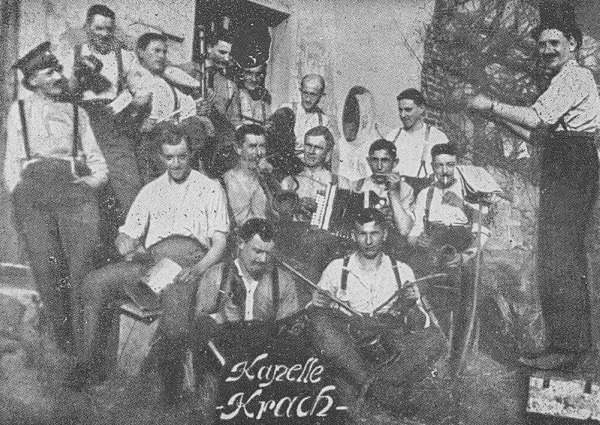
1918 Various:
World War I (August 21-September 27): Gefreiter Adolf Hitler attends a signals training course in Nuremberg. [For further details, Click here.]
Russian Revolution: The All-Russian Central Executive Committee recommends the introduction of a Red terror campaign in retaliation for the recent attack on Lenin. (THP)
1919 John J Pershing on the Meuse-Argonne Offensive:
The definite decision for the Meuse-Argonne phase of the great Allied convergent attack was agreed to in my conference with Marshal Foch and General Petain on September 2nd. It was planned to use all available forces of the First Army, including such divisions and troops as we might be able to withdraw from the St. Mihiel front. The Army was to break through the enemy's successive fortified zones to include the Kriemhilde-Stellung, or Hindenburg Line, on the front Brieulles-Romagne sous Montfaucon-Grandpre, and thereafter, by developing pressure toward Mezieres, was to ensure the fall of the Hindenburg Line along the Aisne River in front of the Fourth French Army, which was to attack to the west of the Argonne Forest. A penetration of some 12 to 15 kilometres was required to reach the Hindenburg Line on our front, and the enemy's defences were virtually continuous throughout that depth.
1923 Weimar: Hitler attends the second day of a rally of Nationalist parties in Nuremberg. (THP)
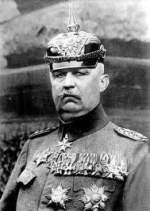
1926 Weimar: General Ludendorff marries Mathilde von Kemnitz: She soon begins spearheading the Ludendorff movement.
With his second wife, Dr. Mathilde von Kemnitz, Ludendorff later founded the mystico-religious Aryan-German Tannenberg League, which actively campaigned against Jews, Marxists, Freemasons, and Jesuits. Ludendorff set down his political views in numerous writings, particularly in his openly militarist The Nation at War (1936). Highly acclaimed by the Nazi regime but isolated in his own mystical politics, Ludendorff died in Munich on Dec. 20 1937.
1930 Aviation: Flying their plane Point d'Intérrogation, French aviators Dieudonne Coste and Maurice Bellonte complete the first nonstop flight from Europe to the United States.
1933 The Soviet Union and Italy sign a pact outlining non-aggression, friendship and neutrality.
1939 World War II: Various:

Speech by the British Prime Minister in the House of Commons:
Only last night the Polish Ambassador did see the German Foreign Secretary, Herr von Ribbentrop. Once again he expressed to him what, indeed, the Polish Government had already said publicly, that they were willing to negotiate with Germany about their disputes on an equal basis. What was the reply of the German Government? The reply was that without another word the German troops crossed the Polish frontier this morning at dawn and are since reported to be bombing open towns. [An Hon. Member: "Gas?"] In these circumstances there is only one course open to us. His Majesty's Ambassador in Berlin and the French Ambassador have been instructed to hand to the German Government the following document:
Early this morning the German Chancellor issued a proclamation to the German Army which indicated clearly that he was about to attack Poland. Information which has reached His Majesty's Government in the United Kingdom and the French Government indicates that German troops have crossed the Polish frontier and that attacks upon Polish towns are proceeding. In these circumstances it appears to the Governments of the United Kingdom and France that by their action the German Government have created conditions, namely, an aggressive act of force against Poland threatening the independence of Poland, which call for the implementation by the Governments of the United Kingdom and France of the undertaking to Poland to come to her assistance. I am accordingly to inform your Excellency that unless the German Government are prepared to give His Majesty's Government satisfactory assurances that the German Government have suspended all aggressive action against Poland and are prepared promptly to withdraw their forces from Polish territory, His Majesty's Government in the United Kingdom will without hesitation fulfil their obligations to Poland.
Poland: German troops capture the Jablunka pass in the Tatra Mountains
Fighting continues for the strategic island of Westerplatte at the mouth of the Vistula River. A massive attack is launched by 60 Stuka dive-bombers of the II and III Stukageschwader Immelmann directed at crushing the island garrison. The air assault is not directly followed up by a German attack from the ground, and the Poles are able to reorganize their defense.
The Polish Army was not yet fully mobilized and unprepared for war, as according to the defence plan - Z (Zachod - West). Poles responded to German attacks on 1600 kilometres long front, attempting to contain the invading force in order to counterattack and protect industrial centres. Polish planners correctly predicted directions of German attacks but knew that they could only delay them in order to allow its Allies to act...On September 1st and 2nd, Polish Army was already involved in heavy fighting (e.g. Battle of Mlawa, Battle of Pomerania), while retreating eastwards in attempt to establish line of defence and delay the invaders.
German aircraft bomb a railway station at Kolo, killing 111 refugees.
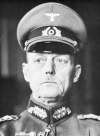
Troops of German Army Group South (Rundstedt) troops are already over the Warta River in many places after rapid but expensive victories in the frontier battles. Krakow is now near the front line. In the north, Fourth Army (Kluge) makes contact with the Third Army (Kuchler) from East Prussia. Two Polish divisions are destroyed while attempting to pull back through the Corridor. The Luftwaffe is spreading chaos in the Polish rear. The Polish regular troops have been stationed too far forward so the German advance is soon in their rear areas.
German Ambassador in the Soviet Union (Schulenburg) to German Foreign Office:
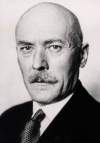
To my probing as to whether Istanbul rumors were correct, in accordance with which Turkey was already negotiating with the Soviet Union, Molotov replied that the Soviet Government was actually engaged in exchange of opinion and was in contact with Turkey. After consultation with Stalin, Molotov informed me at a second conference at 3 PM, that there was only a non-aggression pact between the Soviet Union and Turkey and relations were good in general; the Soviet Government was prepared to work for permanent neutrality of Turkey as desired by us. Our conception of the position of Turkey in the present conflict was shared by the Soviet Government. Please make no use of the above statements of Molotov in dealing with the Turks.
Coulondre telegrams Daladier: 'Stay firm, Hitler will knuckle under.' France revokes its acceptance of Mussolini's peace proposals.
Holocaust: Various:
Stutthof: German control is established in Danzig and a concentration camp is opened outside the city at Stutthof that will be equipped with gas chambers in which 65,000 Polish Christians will perish. Hundreds of Jews are among the first prisoners.
Stutthof is 34 km from Danzig and was the first concentration camp created by the Nazis outside of the country of Germany (September 2nd. 1939). It is also the last camp liberated by the Allies (May 10th 1945). The first prisoners arrived in the camp on September 2nd. 1939: 250 Polish citizens and P.O.W. Two weeks later, on September 15th 1939, there were 6,000 prisoners in the camp: prisoners of war, scientists, etc . . . . Most of them were executed by the SS.
The camp was composed of 8 barracks for the inmates and a huge building (the "Kommandantur") for the SS. It was called "the old camp". In 1942, the SS began to build a "new" camp: 30 barracks were added. In 1943, the Nazis added a crematory and a gas chamber. The gas chamber had a maximum capacity of 150 people at one time. When the SS had too many people to execute, they also used wagons as gas chambers. Between September 2nd 1939 and May 10th 1945, 127,000 prisoners were registered upon their arrival in the camp. The lowest estimation of the number of victims is 85,000. The real number is certainly much higher: the inmates who were selected for immediate execution at their arrival were not registered.
Compulsory labor: The Gestapo orders all Jews in Germany between 16 and 55 years of age to report for compulsory labor. (THP)
1940 World War II: War at Sea: An Agreement between the US and Britain is ratified: The US exchanges 50 old destroyers, veterans of World War I, for British bases in the West Indies and Bermuda. The first ship is taken over by a British crew on September 9.
1942 Holocaust: Various:
Lachwa (Poland): 820 Jews lead by Dov Lopatin revolt against their "liquidation." 700 are killed, 120 escape. Many join a Soviet partisan unit. (THP)
SS Dr. Johann Paul Kremer's Auschwitz Diary: "For the first time, at 3:00 A.M. outside, attended a special action. Dante's Inferno seems to me almost a comedy compared to this. They don't call Auschwitz the camp of annihilation for nothing!"

1943: 1,223 inmates arrive at Nordhausen from Buchenwald. (Sellier)
From Hitler: 1936-1945 Nemesis by Ian Kershaw:Hitler's instincts, as always, veered towards attack as the best form of defense. He looked, as did—mpatiently and more and more disbelievingly—large numbers of ordinary Germans, to the chance to launch devastating weapons of destruction against Great Britain, giving the British a taste of their own medicine and forcing the Allies to rethink their strategy in the air-war. Here, too, his illusions about the speed with which the "wonder-weapons" could be made ready for deployment, and their likely impact on British war strategy, were shored up by the optimistic prognoses of his advisors.
Speer had persuaded Hitler as long ago as October 1942, after witnessing trials at Peenemunde earlier in the year, of the destructive potential of a long-range rocket, the A4 (later known as the V-2) able to enter the stratosphere en route to delivering its bombs—and unstoppable devastation—on England. Hitler had immediately ordered their mass-production on a huge scale. When Wernher von Braun, the genius behind the construction, had explained some months later what the rocket was capable of, and shown a color film of it in trials, Hitler's enthusiasm was unbounded. It was, he told Speer, "the decisive weapon of the war," which would lift the burden on Germany when unleashed on the British. Production was to be advanced with all speed, if need be at the expense of tank production. By autumn 1943 it had already become plain that any expectation of early deployment was wildly optimistic.
1943 Holocaust: Treblinka:

A group of 13 Jewish slave laborers kill their SS guard with a crowbar while working outside the camp. Their leader, 18-year-old Seweryn Klajnman, puts on the guard's uniform, and then "marches off" his fellow prisoners. All escape their pursuers and evade capture. (THP)
World War II: Various:
Troops of the US First Army enter Belgium: More than 6,000 trucks of the Red Ball Express keep gasoline and other vital supplies rolling in as American troops and tanks push the Germans back toward their homeland.
Kishinev: The remnants of German forces surrounded in the Kishinev pocket surrender to the Red Army.
Finland breaks off diplomatic relations with Germany and demands the withdrawal of all German forces on Finnish soil.
Navy aviator George H.W. Bush and his squadron attacked
On this day in 1944, future President George Herbert Walker Bush is serving as a torpedo bomber pilot in the Pacific theater of World War II when his squadron is attacked by Japanese anti-aircraft guns. Bush was forced to bail out of the plane over the ocean. According to the Navy's records, Bush's squadron was conducting a bombing mission on a Japanese installation on the island of Chi Chi Jima in the Pacific when they encountered heavy anti-aircraft fire. The engine on Bush's plane was set ablaze, yet Bush managed to release his bombs and head back toward the aircraft carrier San Jacinto before bailing out over the water. Three other crew members perished in the attack. After floating on a raft for four hours, a submarine crew fished a safe but exhausted Bush out of the water. His bravery in action earned him a Distinguished Flying Cross. The previous June, Bush had experienced a similar close call with death when he was forced to make a crash landing on water after a bombing run; a U.S. destroyer crew rescued him from the sea. After his harrowing experience near Chi Chi Jima, Bush returned to the San Jacinto and continued to pilot torpedo bombers in several successful missions. Over the course of 1944, while his squadron suffered a 300 percent casualty rate among its pilots, an undaunted Bush won three Air Medals as well as a Presidential Unit Citation. In total, Bush flew 58 combat missions during the war. In December 1944, Bush was reassigned to Norfolk Naval Base in Norfolk, Virginia, where he was tasked with training new pilots. He received an honorable discharge from the Navy in September 1945 after the Japanese surrender. (History.com)
The Warsaw Uprising: Germans murder more than 500 villagers in Majorat near Warsaw.
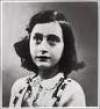
1944 Holocaust: Anne Frank is sent to Auschwitz.
Medical experiments: Professor C. Schneider writes in a letter about the reverses which his research project has suffered:
The people in Eichberg . . . maintain that they knew nothing of our experiments being continued, even though one of our collaborators had been going there from time to time . . . so, I have to reckon with the fact that only half the idiots whom we have investigated here will be available to us for a full examination. (THP)
1945 World War II: Japan surrenders:
Aboard the USS Missouri in Tokyo Bay, Japan formally surrenders to the Allies, bringing an end to World War II.
By the summer of 1945, the defeat of Japan was a foregone conclusion. The Japanese navy and air force were destroyed. The Allied naval blockade of Japan and intensive bombing of Japanese cities had left the country and its economy devastated. At the end of June, the Americans captured Okinawa, a Japanese island from which the Allies could launch an invasion of the main Japanese home islands. U.S. General Douglas MacArthur was put in charge of the invasion, which was code-named "Operation Olympic" and set for November 1945.
The invasion of Japan promised to be the bloodiest seaborne attack of all time, conceivably 10 times as costly as the Normandy invasion in terms of Allied casualties. On July 16, a new option became available when the United States secretly detonated the world's first atomic bomb in the New Mexico desert. Ten days later, the Allies issued the Potsdam Declaration, demanding the "unconditional surrender of all the Japanese armed forces." Failure to comply would mean "the inevitable and complete destruction of the Japanese armed forces and just as inevitable the utter devastation of the Japanese homeland." On July 28, Japanese Prime Minister Kantaro Suzuki responded by telling the press that his government was "paying no attention" to the Allied ultimatum. U.S. President Harry Truman ordered the devastation to proceed, and on August 6, the U.S. B-29 bomber Enola Gay dropped an atomic bomb on the Japanese city of Hiroshima, killing an estimated 80,000 people and fatally wounding thousands more.
After the Hiroshima attack, a faction of Japan's supreme war council favored acceptance of the Potsdam Declaration, but the majority resisted unconditional surrender. On August 8, Japan's desperate situation took another turn for the worse when the USSR declared war against Japan. The next day, Soviet forces attacked in Manchuria, rapidly overwhelming Japanese positions there, and a second U.S. atomic bomb was dropped on the Japanese coastal city of Nagasaki.
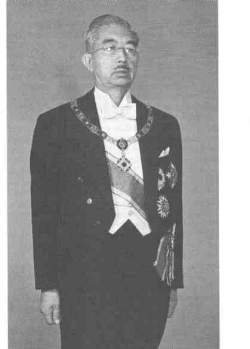
Just before midnight on August 9, Japanese Emperor Hirohito convened the supreme war council. After a long, emotional debate, he backed a proposal by Prime Minister Suzuki in which Japan would accept the Potsdam Declaration "with the understanding that said Declaration does not compromise any demand that prejudices the prerogatives of His Majesty as the sovereign ruler." The council obeyed Hirohito's acceptance of peace, and on August 10 the message was relayed to the United States.
Early on August 12, the United States answered that "the authority of the emperor and the Japanese government to rule the state shall be subject to the Supreme Commander of the Allied Powers." After two days of debate about what this statement implied, Emperor Hirohito brushed the nuances in the text aside and declared that peace was preferable to destruction. He ordered the Japanese government to prepare a text accepting surrender.
In the early hours of August 15, a military coup was attempted by a faction led by Major Kenji Hatanaka. The rebels seized control of the imperial palace and burned Prime Minister Suzuki's residence, but shortly after dawn the coup was crushed. At noon that day, Emperor Hirohito went on national radio for the first time to announce the Japanese surrender. In his unfamiliar court language, he told his subjects, "we have resolved to pave the way for a grand peace for all the generations to come by enduring the unendurable and suffering what is insufferable." The United States immediately accepted Japan's surrender.
President Truman appointed MacArthur to head the Allied occupation of Japan as Supreme Commander of the Allied Powers. For the site of Japan's formal surrender, Truman chose the USS Missouri, a battleship that had seen considerable action in the Pacific and was named after Truman's native state. MacArthur, instructed to preside over the surrender, held off the ceremony until September 2 in order to allow time for representatives of all the major Allied powers to arrive.
On Sunday, September 2, more than 250 Allied warships lay at anchor in Tokyo Bay. The flags of the United States, Britain, the Soviet Union, and China fluttered above the deck of the Missouri. Just after 9 a.m. Tokyo time, Japanese Foreign Minister Mamoru Shigemitsu signed on behalf of the Japanese government. General Yoshijiro Umezu then signed for the Japanese armed forces, and his aides wept as he made his signature.
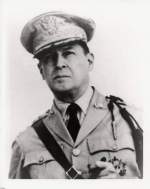
Supreme Commander MacArthur next signed on behalf of the United Nations, declaring, "It is my earnest hope and indeed the hope of all mankind that from this solemn occasion a better world shall emerge out of the blood and carnage of the past." Ten more signatures were made, by the United States, China, Britain, the USSR, Australia, Canada, France, the Netherlands, and New Zealand, respectively. Admiral Chester W. Nimitz signed for the United States. As the 20-minute ceremony ended, the sun burst through low-hanging clouds. The most devastating war in human history was over.(History.com)
We hereby proclaim the unconditional surrender to the Allied Powers of the Japanese Imperial General Headquarters and of all Japanese armed forces and all armed forces under the Japanese control wherever situated. We hereby command all Japanese forces wherever situated and the Japanese people to cease hostilities forthwith.
General Order Number One is issued shortly after the signing of the Instrument of Surrender in Tokyo Bay, by General of the Army Douglas MacArthur, Supreme Commander for the Allied Powers.
US President Harry 'We Gave Em Hell' Truman proclaims this day as Victory-over-Japan Day (V-J Day or Victory Day).
Proclamation: On the order of General Douglas MacArthur, Supreme Commander for the Allied Powers, Emperor Hirohito issues the following Proclamation prior to the signing of the Instrument of Surrender:
Japanese Imperial General Headquarters will furnish to the Supreme Commander for the Allied Powers (within time limit of the receipt of this order) complete lists of all United Nations prisoners of war and civilian internees, indicating their location. Tenth, all Japanese and Japanese-controlled military and civil authorities shall aid and assist the occupation of Japanese-controlled areas by forces of the Allied Powers. Eleventh, Japanese Imperial General Headquarters and appropriate Japanese officials shall be prepared, on instructions from Allied occupation commanders, to collect and deliver all arms in the possession of the Japanese civilian population. Twelfth, this and all subsequent instructions issued by the Supreme Commander for the Allied Forces or other Allied military authorities will be scrupulously and promptly obeyed.
Vietnam independence proclaimed:
Hours after Japan's surrender in World War II, Vietnamese communist Ho Chi Minh declares the independence of Vietnam from France. The proclamation paraphrased the U.S. Declaration of Independence in declaring, "All men are born equal: the Creator has given us inviolable rights, life, liberty, and happiness!" and was cheered by an enormous crowd gathered in Hanoi's Ba Dinh Square. It would be 30 years, however, before Ho's dream of a united, communist Vietnam became reality. [For further details, Click here]
1946 Nuremberg Tribunal: The justices meet to discuss verdicts in the Major War Criminals Trial. (See: 30 September 1946)
1965 Death: Johannes Bobrowski: German lyricist, narrative writer, adaptor and essayist. As a member of the Confessional Church, Bobrowski had contact to the Christian resistance against National Socialism. He was a lance corporal for the entire Second World War in Poland, France, and the Soviet Union. In 1943 he married Johanna Buddrus. From 1945-1949 Bobrowski was imprisoned by the Soviet Union, where he spent time working in a coal mine. On his release, he worked as an editor in Berlin.
1987 Cold War: Trial of Mathias Rust begins:
The trial of Mathias Rust, the 19-year-old pilot who flew his Cessna plane into Red Square in May 1987, begins in Moscow. Rust had become an international celebrity following his daring intrusion into Soviet airspace and landing in the center of Moscow, but the Soviet government condemned his actions. [For further details, Click here]
1998 A UN court hands down the first international conviction for genocide:
A United Nations court finds Jean-Paul Akayesu, the former mayor of a small town in Rwanda, guilty of nine counts of genocide, marking the first time that the 1948 law banning genocide is enforced. Because mass killings had occurred in several countries since the law went into effect, the UN received heavy criticism for waiting 50 years before finally enforcing it. [For further details, Click here]
Edited by Levi Bookin (Copy editor)
levi.bookin@gmail.com



Click to join 3rdReichStudies

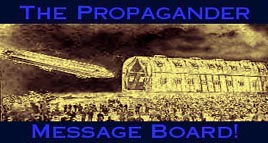

Disclaimer: This site includes diverse and controversial materials--such as excerpts from the writings of racists and anti-Semites--so that its readers can learn the nature and extent of hate and anti-Semitic discourse. It is our sincere belief that only the informed citizen can prevail over the ignorance of Racialist "thought." Far from approving these writings, this site condemns racism in all of its forms and manifestations.
Fair Use Notice: This site may contain copyrighted material the use of which has not always been specifically authorized by the copyright owner. We are making such material available in our efforts to advance understanding of historical, political, human rights, economic, democracy, scientific, environmental, and social justice issues, etc. We believe this constitutes a "fair use" of any such copyrighted material as provided for in section 107 of the US Copyright Law. In accordance with Title 17 U.S.C. Section 107, the material on this site is distributed without profit to those who have expressed a prior interest in receiving the included information for research and educational purposes. If you wish to use copyrighted material from this site for purposes of your own that go beyond 'fair use', you must obtain permission from the copyright owner.
Please Note: The list-owner and the moderator of 3rdReichStudies are not responsible for, and do not necessarily approve of, the random ads placed on our pages by our web server. They are the unfortunate price one pays for a 'free' website.